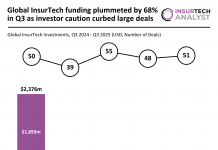The insurance industry is undergoing rapid transformation, and as we embark on a new year, it’s essential to anticipate the key trends and developments shaping its future. InsurTech firm Novidea delves into its top ten predictions for the insurance sector in 2024.
1. Legacy tech to be phased out
Outdated technology infrastructure has long plagued the insurance industry. However, with mounting pressure to stay competitive and the emergence of innovative solutions addressing longstanding concerns, organisations are poised to embrace digital transformation in 2024. Novidea’s 2023 global survey revealed that 99% of insurance entities have plans to upgrade their technology systems, with a significant focus on broker/agency management platforms and policy administration systems.
Moreover, the need to comply with Lloyd’s Blueprint 2.0, is forcing UK brokers’ hands, with the majority of firms looking to upgrade their core systems in 2024.
2. Customer centricity reaches new heights
Customer expectations for seamless digital experiences continue to rise. In response, insurance organisations are prioritising customer-centricity, with a strong emphasis on providing personalised services and enhancing user experiences. Novidea’s survey underscored that 87% of respondents view delivering value to customers as a top priority when selecting new technology solutions.
The London-based firm doubled down on this, stating that changes that don’t improve a customer’s experience are simply not worth doing.
3. Revolutionising claims handling
The need for faster and smarter claims processing is paramount in 2024.
Lemonade‘s record-breaking two-second claim settlement underscored the urgency for insurance organisations to enhance their claims handling processes. Leveraging technologies such as AI and machine learning will be crucial in delivering superior claims experiences and retaining customers.
4. Innovation fuels product development
The insurance landscape continues to evolve with the introduction of new and niche products. From cyber insurance to pet insurance, innovative offerings are reshaping the market and driving revenue growth. Increased competition is expected to drive further product innovation in 2024.
5. Talent acquisition takes centre stage
In 2023, major companies such as Amazon, Alphabet, and Microsoft underwent significant layoffs, citing ‘economic uncertainty’ as the primary cause. This resulted in a surplus of skilled professionals seeking job opportunities. Concurrently, the insurance industry is bracing for a considerable wave of retirements, with nearly 400,000 individuals expected to exit the workforce in the coming years. Filling these critical roles with fresh talent is imperative for the industry’s sustainability. However, despite the demand for talent, a concerning trend persists: eight out of ten millennials express a lack of awareness regarding employment prospects within the insurance sector. This discrepancy is largely attributed to the industry’s perception as antiquated and out-of-touch with modern trends.
Therefore, as we progress into 2024, the insurance sector anticipates a significant influx of job openings alongside an available pool of fresh talent resulting from corporate layoffs. The pivotal question now is which insurance organisations will successfully attract top-tier talent by embracing technological modernisation and fostering an environment conducive to innovation and growth.
6. Rising Frequency of Catastrophic Events
Climate change-induced catastrophes are on the rise, posing significant challenges for insurers. While these events lead to increased claims and losses, they also underscore the importance of insurance coverage. In 2024, insuring against such risks will become more critical than ever, as floods, hurricanes, landslides, extreme heat, and other events are becoming increasingly common and damaging
7. Data’s Growing Role in Risk Assessment
8. Post-merger integration challenges
The M&A frenzy witnessed in recent years will give way to integration challenges in 2024. Newly merged organisations will focus on aligning cultures, standardising technologies, and streamlining workflows to operate as a cohesive entity.
9. Rise of vertical SaaS
Traditional InsurTech solutions were generally designed to cater to a wide range of needs, following a one-size-fits-all approach. However, in various other industries, we’ve witnessed the rising popularity of software specifically tailored to meet the unique requirements of specific sectors.
Looking ahead to 2024, Novidea anticipates a significant shift in our industry towards vertical specialisation. This means that more customised software solutions will emerge, designed to address the specific needs of insurance businesses. This shift towards bespoke digital tools will demonstrate the significant benefits they can offer to insurance companies.
10. Generative AI takes centre stage
As of January 2023, ChatGPT had emerged as the fastest-growing consumer software application ever, boasting a user base exceeding 100m. Throughout 2023, numerous competing products entered the market, offering businesses and consumers a glimpse into the capabilities and limitations of these tools.
Looking ahead to 2024, these software applications are poised to play an even more significant role in both business and personal operations. As these tools evolve, insurance organisations will continue to explore ways to leverage them for tasks such as underwriting and claims handling.
All indications suggest a substantial transformation within the insurance industry this year. Amidst such rapid change, it’s understandable to feel overwhelmed. However, it’s essential to recognise that all industries undergo evolutionary phases.
The decisions made today by insurance organisations will undoubtedly shape future opportunities for growth.
Copyright © 2024 InsurTech Analyst










